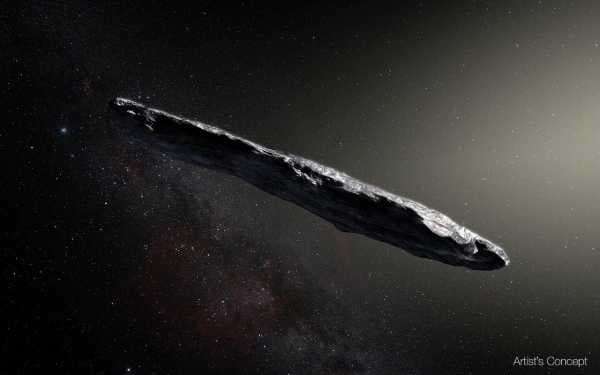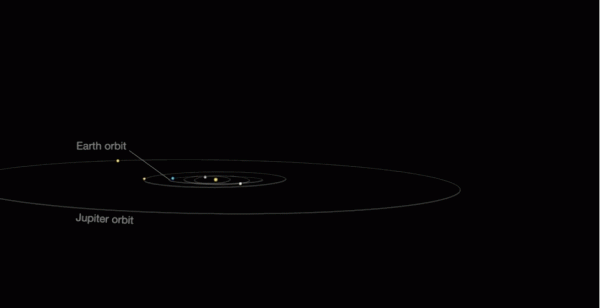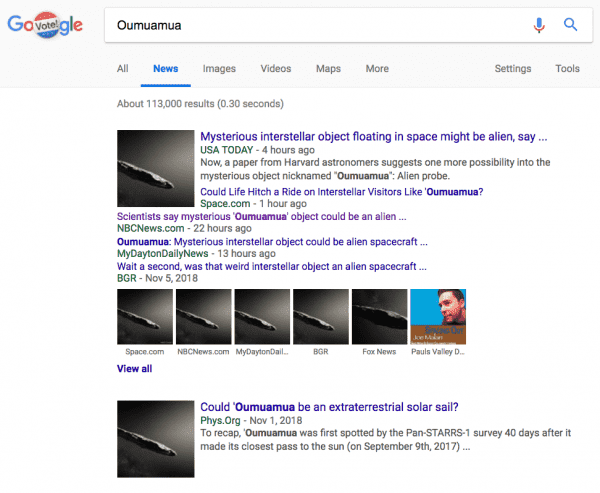
In October 2017, astronomers operating the Pan-STARRS1 telescope in Maui found a bizarre cigar-shaped rock blazing its way through our solar system.
The astronomers thought it might be an asteroid. But unlike the millions of known asteroids in our solar system, this one was traveling so fast — more than 70,000 miles per hour — that it couldn’t be captured by our sun’s gravity, the scientists reasoned. For reference, Voyager 1, the spacecraft that’s currently leaving our solar system, is traveling at around 35,000 mph.
Since the rock was the first interstellar object ever spotted in our solar system, the scientists called it Oumuamua — a Hawaiian word meaning either “scout” or “messenger sent from the distant past to reach out to us.” But they had no idea where it came from. And they still don’t know whether it was truly an asteroid, or something more closely resembling a comet.
This year, the mystery of Oumuamua deepened further. After slingshotting around the sun with enough speed to overcome the grasp of its gravity, it did something a bit unexpected: It sped up, propelled by some inexplicable force.
“There was something affecting its motion other than the gravitational forces of the Sun and planets,” Marco Micheli of the European Space Agency, which was tracking the object, said in a June press statement. When the Hubble Space Telescope spotted Oumuamua in the beginning of January 2018, it was some 25,000 miles ahead of its expected trajectory (see the GIF below), as a paper by Micheli and co-authors in Nature explains.

Oumuamua is a very mysterious, fascinating object
There could be a very simple explanation for Oumuamua’s acceleration. Like a comet, it may have been expelling debris and gases from its surface; that would be enough to propel it along like rocket fuel burning off the end of a spacecraft.
However, astronomers saw no visible evidence of these jets. Also confusing: When Oumuamua was closest to the sun, it didn’t break apart like a comet would amid the heat and display a telltale tail. So there’s evidence both for and against the hypothesis that Oumuamua is a comet or comet-like.
There is also a new, um … far-out-there explanation for Oumuamua’s speed.

Was it sent to us by intelligent alien life? (Spoiler: Unlikely!)
In a forthcoming paper in Astrophysical Journal Letters, Harvard professors Shmuel Bialy and Abraham Loeb revisit the observations of Oumuamua and find that its motion does indeed seem to be explained by normal phenomena (Loeb is the head of Harvard’s astronomy department). They find that solar radiation pressure — i.e., the force the sun’s radiation exerts on objects — is a plausible explanation for the object’s acceleration, especially when they consider Oumuamua’s odd elongated shape.
At the very end of the paper, they throw out another hypothetical explanation: “Alternatively, a more exotic scenario is that ‘Oumuamua may be a fully operational probe sent intentionally to Earth vicinity by an alien civilization.”
Exotic indeed. It’s possible, they suggest, that Oumuamua is a light sail, a type of spacecraft propulsion device.
You can think of a light sail as being like a kite, but instead of being pushed by air in our atmosphere, radiation from the sun propels it forward. Humans have designed these light sails (there’s a pretty gonzo plan in the works called Breakthrough Starshot to develop solar sails propelled by lasers to send tiny spacecraft to the star Alpha Centauri. As The Verge points out, Loeb is the chair of the advisory board for this project.) So you may think, “Well, an advanced alien species might be able to make these things as well.”
It’s a fun thought, but Bialy and Loeb present nothing beyond hypothetical evidence this could be the case. It’s extremely unlikely that Oumuamua is actually an alien spacecraft, propelled by some sort of alien technology. As this excellent Vox piece by Liv Boeree explains, if other intelligences exist, they are probably far beyond the cosmological horizon and therefore forever invisible to us.
Yet which of Bialy and Loeb’s findings do you think got most of the press attention?

Here’s the thing: Oumuamua doesn’t have to be an object created by an alien species to be cool. It’s still the first interstellar object we’ve ever witnessed crossing into our solar neighborhood.
And scientists still don’t know if it represents an entirely new class of objects — neither comet nor asteroid — that are hurtling through the galaxy. (Bialy and Loeb argue it does represent a new class, writing it was “either produced naturally, through a yet unknown process in or in proto-planetary disks, or of an artificial origin.”)
There are less “exotic” explanations for Oumuamua that are still brain-meltingly awesome. One, as Quanta magazine outlines, is the possibility is that Oumuamua is a shard of a planet that was blown up by a dying star. How cool would that be?
Oumuamua is indeed an odd, alien object. Just probably not the type you’ve seen in the movies.
Further reading
- The Verge’s Loren Grush interviewed Loeb, who is “fairly certain that his [alien] idea is correct.”
- The Fermi Paradox, and the reason we’re unlikely to find intelligent alien life, explained
Sourse: vox.com






